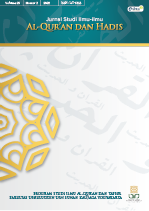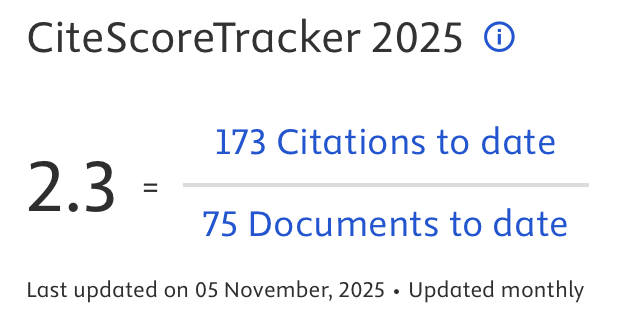Manhaj Ibn ‘Aṭiyyah fī al-Taʻāmul ma’a al-Isrā’īliyyāt fī al-Muḥarrar al-Wajīz
DOI:
https://doi.org/10.14421/qh.v23i2.3756Keywords:
methods, Ibn Atiyya, Israiliyyat, tafsir, al-Muharrar al-WajizAbstract
This article aims to explain Ibn Atiyya’s method to revealing Israiliyyat stories in his interpretation of al-Muharrar al-Wajiz. This research is an attempt to see how far Ibn Atiyya’s consistency is in applying the general method he has described in the preliminary of his tafsir when interacting with Israiliyyat stories. Apart from that, this research also seeks to explore Ibn Atiyya’s detailed method when presenting the Israiliyyat narrations in its interpretation and expose the practical examples as the application of the method. Using the analytical descriptive method, this study finds that Ibn Atiyya is quite consistent in applying the general method he has described in the preliminary of his tafsir by mentioning important Israiliyyat stories that can’t be separated from the explanation of the meaning of the verse. In contrast to the previous commentators who mentioned the Israiliyyat narrations in length and width, Ibn Atiyya described Israiliyyat reports briefly and criticized the narrations that had no basis or arguments sahih that could be justified. In addition, this study also found that Ibn Atiyya was careful in taking Israiliyyat stories and trying to free the tafsir from the Israiliyyat stories which was not based on the explanation of the Prophet Muhammad. Ibn Atiyyah also calls for reducing the stories of Israiliyyat in the tafsir literature and sometimes also adding comments and criticisms to the narrations of Israiliyyat that he mentions.
 Abstract viewed: 730 times
|
Abstract viewed: 730 times
|
 PDF downloaded = 320 times
PDF downloaded = 320 times
References
Al-Abbar, Muhammad bin Abdullah bin Abu Bakr bin Abdullah bin Abdurrahman al-Quda’i bin. Al-Mu’jam fi Ashab Abi ‘Ali al-Sadafi. 1st ed. Cairo: Maktabah al-Saqafah al-Diniyyah, 2000.
‘Anan, Muhammad ‘Abdullah. ‘Asr al-Murabitin fi al-Magrib wa al-Andalus. 1st ed. Cairo: Lajnah al-Ta’lif wa al-Tarjamah wa al-Nasyr, 1383H.
Al-‘Asqalani, Ahmad bin Ali bin Muhammad bin Ali bin Hajar. Fath al-Bary Syarh Sahih al-Bukhary. n.d. Beirut: Dar al-Ma’rifah, 1379 H.
‘Atiyyah, Abdulhaq bin Abu Bakr Galib bin. Fihris Ibn ‘Atiyyah. 2nd ed. Beirut: Dar al-Garb al-Islami, 1983.
________________. al-Muharrar al-Wajiz fi Tafsir al-Kitab al-‘Aziz. 1st ed. Beirut: Dar al-Kutub al-‘Ilmiyyah, 1422 H.
Avivy, Achmad Levi Fachrul, Jawiah Dakir and Mazlan Ibrahim. “Isra’iliyyat in Interpretative Literature of Indonesia: A Comparison between Tafsir Marah Labid and Tafsir al-Azhar”. Mediterranian Journal of Social Science 6, no. 3, 2015, 401.
Baihaqi, Yusuf . “Isra‘iliyyat dan Pengaruhnya terhadap Kitab Kulliyyat Rasa‘il al -Nur Karangan Said Al-Nursi”. Ijtima’iyya Vol. 9 No. 2 Agustus (2016).
Basykuwal, Khalaf bin Abdul Malik bin Mas’ud bin Musa bin. al-Silah. n.d. Cairo: Maktabah al-Khanji, 1374 H.
Bauer, Karen. “Justifying the Genre: A Study of Introductions to Classical Works of Tafsir”. In Aims, Methods, and Contexts of Qur’anic Exegesis (2nd /8th-9th/15th), edited by Karen Bauer, 46. London: Oxford University Press in assosiation with the Institute of Ismaili Studies, 2013.
Albayrak, Ismail. Israiliyyat and Classical Exegetes Comments on the Calf with the Hollow Sound Q. 20:83-98 / 7: 147-155 with Spesial Reference to Ibn ‘Atiyyah”. Journal of Semitic Studies XLVII, no. 1 (2002), 39-65.
_______________. “Qur’anic Narrative and Israiliyyat in Western Scholarship and in Classical Exegesis”. Thesis, Leeds, University of Leeds, 2000, 289-290.
_______________.. “Reading the Bible in the Light of Muslim Sources: From Isrāīliyyāt to Islāmiyyāt.” Islam and Christian-Muslim Relations 23, no. 2 (2012).
Al-Bukhari, Muhammad bin Isma’il. Shahih al-Bukhari. Beirut: Dar Ibn Katsir, 2002.
Farhun, Ibrahim bin Ali bin Muhammad bin. al-Dibaj al-Mazhab fi Ma’rifat A’yan ‘Ulama al-Mazhab. 1st ed. Egypt: Tab’ah ‘Abbas bin Syaqrun, 1351 H.
Fayd, Abdul Wahhab, Manhaj Ibn ‘Atiyyah fi Tafsir al-Qur’an al-Karim. n.d. Cairo: al-Hai’ah al-‘Ammah, 1993.
Fierro, Maribel. “Batinism in al-Andalus. Maslama ibn Qasim al-Qurtubi (d. 354/ 964), Author of the ‘Rutbat al-Hakim’ and the Gayah al-Hakim (Picatrix).” Studia Islamica, Brill, no. 84 (1996): 105-106.
Gilliot, Claude, and Jane Dammen McAuliffe. “Exegesis of the Qur’an: Classical and Medieval.” In Encyclopaedia of the Qur’an, 2:112. Leiden-Boston: Brill, 2006.
Al-Hadrami, Abu Zayd bin Muhammad bin Khaldun. al-Muqaddimah. 1st ed. Cairo: Lajnah al-Bayan al-’Arabi, 1379 H.
Al-Harani, Ahmad bin Abdussalam bin Abdullah bin Taimiyyah. Muqaddimah fi Usul al-Tafsir. 1st ed. Damascus: Matba’ah alTaraqqiyy, 1355 H.
Al-Kalbiy, Abu al-Qasim bin Juzay. al-Tashil li ‘Ulum al-Tanzil. 1st ed. Beirut: Dar al-Arqam, 1416 H.
Kasir, Abu al-Fida’ Isma’il bin ‘Umar bin. Tafsir al-Qur’an al-‘Azim. 1st ed. Beirut: Dar al-Kutub al-‘Ilmiyyah, 1419 H.
__________________. Al-Bidayah wa al-Nihayah. Beirut: Dar Ihya’ al-Turats al-‘Arabi, 1988.
Khaqan, Abu Nasr al-Fath bin Muhammad bin ‘Ubaidillah bin. Qalaid al-‘Aqyan. 1st ed. Cairo: Matba’ah al-Taqaddum al-‘Ilmiyyah, 1320 H.
Al-Khatib, Lisan al-Din Muhammad bin. al-Ihatah fi Akhbar Garnatah. 1st ed. Beirut: Dar al-Kutub al-‘Ilmiyyah, 1424 H.
Mahmud Syukri al-Alusi, Ruh al-Ma’ani fi Tafsir al-Qur’an al-Karim wa al-Sab’ al-Masani. n.d. Beirut: Dar Ihya’ al-Turas al-‘Arabiy, n.d.
Makhluf, Muhammad bin Muhammad bin Umar Qasim. Syajarah al-Nur al-Zakiyyah. 2nd ed. Beirut: Dar al-Kutub al-‘Ilmiyyah, 2010.
Manna’ bin Khalil al-Qattan, Mabahis fi ‘Ulum al-Qur’an. 3rd ed. Riyad: Maktabah al-Ma’arif, 2000.
Muni’ ‘Abd al-Halim Mahmud, Manahij al-Mufassirin. Cairo: Dar al-Kitab al-Misriy, 2000.
Na’na’ah,Ramzi. Al-Isra’iliyyat wa Asaruha fi Kutub al-Tafsir. Damaskus: Dar al-Qalam, 1970.
Noor, Ahmad Yunus Mohd, and Zahidah Zainal Abidin. “Perbahasan Isu Isra’iliyyat Dalam Corpus Al-Isra’iliyyat Wa Al-Mawdu’at Fi Kutub Al-Tafsir Oleh Shaykh Abu Shahbah (1914-1983).” Al-Turath Journal of Al-Quran and Al-Sunnah 3, no. 1 (2018).
Al-Nubbahi, Ali bin Abdullah bin Muhammad bin Muhammad bin al-Hasan. Tarikh Qudat al-Andalus, n.d. Cairo: Dar al-Kitab al-Misriy, 1984.
Saleh, Walid. “Preliminary Remarks on the Historiography of Tafsir in Arabic: A History of the Book Approach”. Journal of Wur’anic Studies 12 (2010), 20.
Şentürk, Mustafa. “HZ. MÛSÂ VE HIZIR (AS) KISSASI: İsrâîliyyât Rivâyetlerine Karşı Eleştirel Bir Yaklaşım.” Amasya Üniversitesi İlahiyat Fakültesi Dergisi (2015).
Shofa, Maryam. “Ad-Dakhil dalam Tafsir al-Jami’ li Ahkam al-Qur‘an Karya al-Qurtubī: Analisis Tafsir Surah al-Baqarah.” Suhuf, Vol. 6 No. 2 (2013).
Suwailim, Abu Syuhbah Muhammad bin Muhammad bin al-Israiliyyat wa al-Maudu’at fi Kutub al-Tafsir. 4th ed. Cairo: Maktabah al-Sunnah, n.d.
Totolli, Roberto. “Origin and Use of the Term Israiliyyat in Muslim Literature”. Arabica, Brill 46, no. 2 (1999), 193-210.
Al-‘Usaimin, Muhammad bin Shalih. Usul fi al-Tafsir. Beirut: al-Maktabah al-Islamiyah, 2001.
Al-Yahsabi, ‘Iyad bin Musa. Al-Gunyah Fihris Syuyukh al-Qadi ‘Iyad. 2nd ed. Beirut: Dar al-Garb al-Islami, 1989.
Al-Zahabi, Abu ‘Abdillah Muhammad. Al-Israiliyyat fi al-Tafsir wa al-Hadis. Cairo: Maktabah Wahbah, 1986.
_____________. Tazkirah al-Huffaz. 3rd ed. India: Dairah al-Ma’arif al-‘Usmaniyyah, 1377 H.
______________. Al-Tafsir wa al-Mufassirun. Cairo: Maktabah Wahbah, n.d.
Al-Zarkali, Khairuddin. Al-A’lam. n.d. Beirut: Dar al-‘Ilm li al-Malayin, 2002.
Al-Zarkasyi, Abu ‘Abdillah Muhammad bin Ibrahim. Tarikh al-Qudat al-Daulatain al-Muwahhidiyyah wa al-Hafsiyyah. 1st ed. Tunisia: al-Daulah al-Tunisiyyah, 1289 H.
Downloads
Published
How to Cite
Issue
Section
License
Copyright (c) 2022 Subi Nur Isnaini

This work is licensed under a Creative Commons Attribution-NonCommercial-NoDerivatives 4.0 International License.
Publishing your paper with Jurnal Studi Ilmu-ilmu al-Qur'an dan Hadis means that the author or authors retain the copyright in the paper. Jurnal Studi Ilmu-ilmu al-Qur'an dan Hadis uses license CC-BY-NC-ND or an equivalent license as the optimal license for the publication, distribution, use, and reuse of scholarly works. This license permits anyone to copy and redistribute the material in any medium or format and must give appropriate credit, provide a link to the license, and indicate if changes were made. If you remix, translate, transform or build upon the material you may use it for private use only and not for distribution. Jurnal Studi Ilmu-ilmu al-Qur'an dan Hadis granted an exclusive non-commercial reuse license by the author(s), but the author(s) are able to put the paper onto a website, distribute it to colleagues, give it to students, use it in your thesis, etc, so long as the use is not directed at a commercial advantage or toward private monetary gain. The author(s) can reuse the figures and tables and other information contained in their paper published by Jurnal Studi Ilmu-ilmu al-Qur'an dan Hadis in future papers or work without having to ask anyone for permission, provided that the figures, tables, or other information that is included in the new paper or work properly references the published paper as the source of the figures, tables or other information, and the new paper or work is not direct at a private monetary gain or commercial advantage.
Jurnal Studi Ilmu-ilmu al-Qur'an dan Hadis journal Open Acces articles are distrubuted under the Creative Commons Attribution-NonCommercial-NoDerivatives 4.0 International (CC BY-NC-ND 4.0). Article can be read, copy and redistribute the material ini any medium or format under the following conditions:
Attribution — You must give appropriate credit, provide a link to the license, and indicate if changes were made. You may do so in any reasonable manner, but not in any way that suggests the licensor endorses you or your use.
NonCommercial — You may not use the material for commercial purposes.
NoDerivatives — If you remix, transform, or build upon the material, you may not distribute the modified material.










